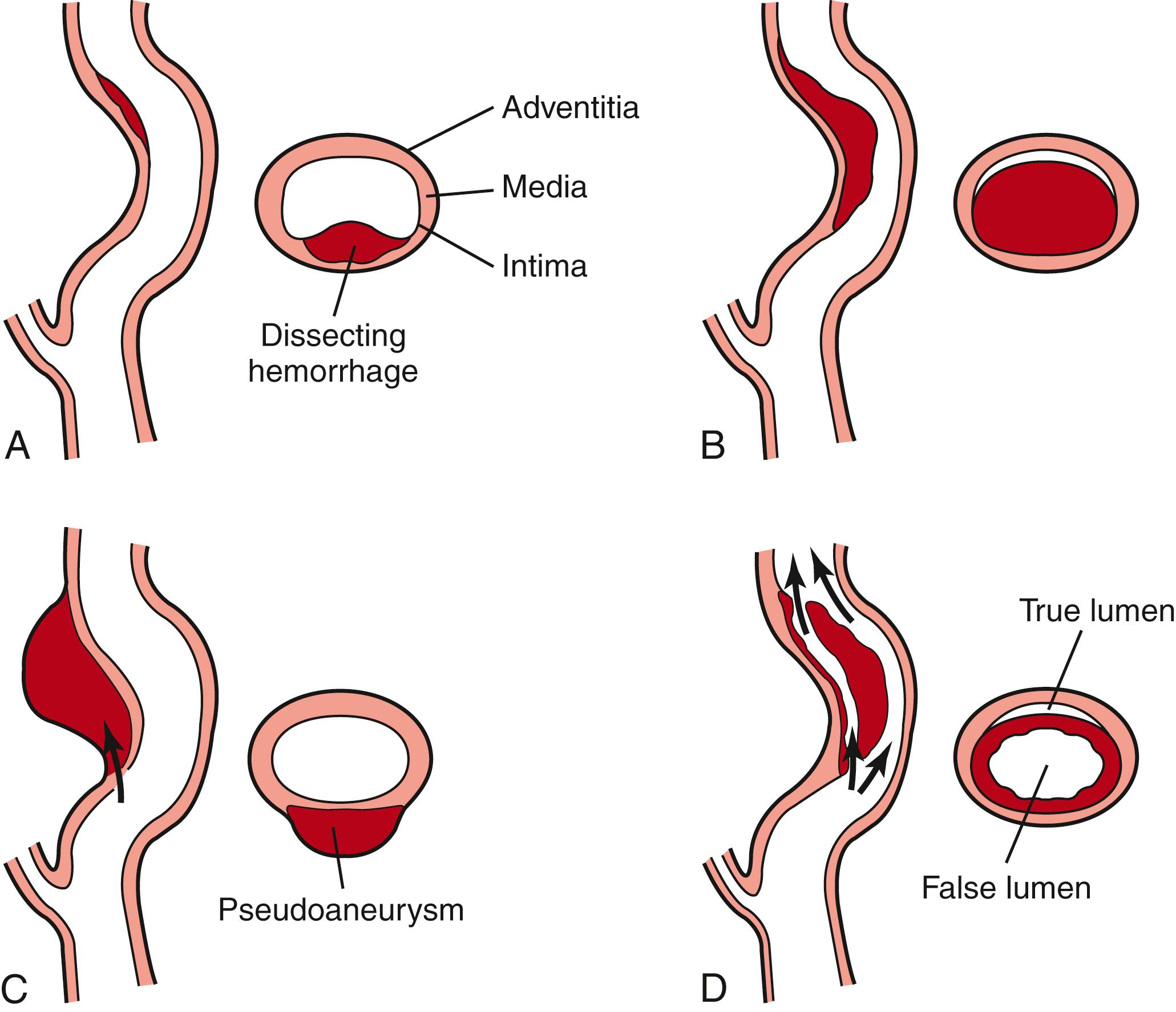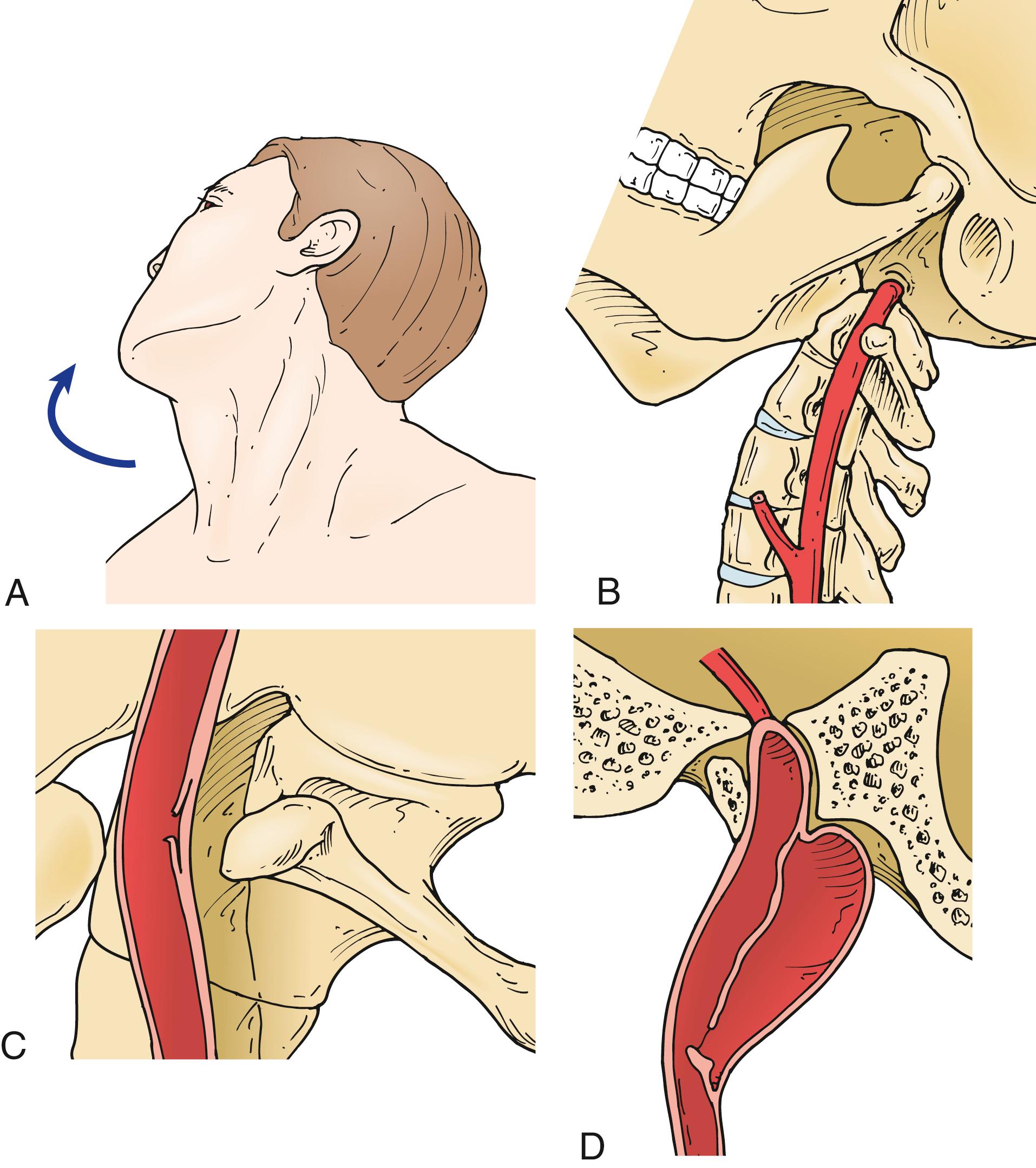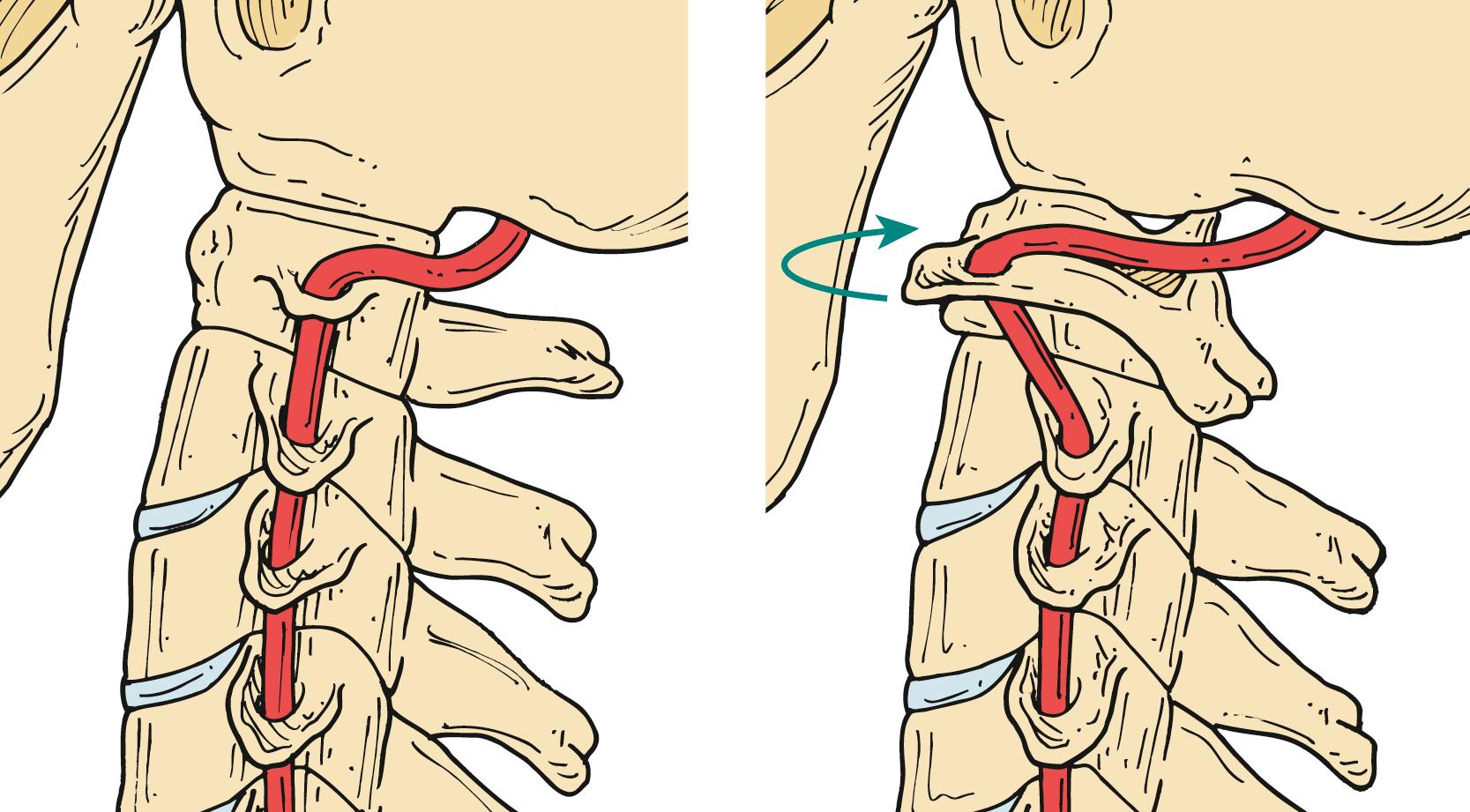Physical Address
304 North Cardinal St.
Dorchester Center, MA 02124
Cervicocerebral arterial dissection constitutes 2% of strokes occurring most frequently in young and middle-aged populations.
Medical interventions depending on the timing and severity of initial presentation and site of dissection may include thrombolytics, antiplatelet agents, or anticoagulation.
Clinical prognosis of extracranial dissection is associated with excellent outcome in 70%–85% of cases with mortality less than 5%.
Fibromuscular dysplasia (FMD) is an uncommon nonatheromatous, noninflammatory vasculopathy that may be associated with cervicocerebral dissection or ischemia.
Most cases are asymptomatic, although symptomatic FMD may be treated with antithrombotic therapy depending on the clinical presentation.
Cervicocerebral arterial dissection constitutes 2% of strokes, occurring most frequently in young and middle-aged populations. The site of cervicocerebral dissection dictates differences in clinical presentation, complications, and prognosis. Diagnostic modalities including magnetic resonance imaging (MRI), magnetic resonance angiography (MRA), and computed tomographic angiography (CTA) are the most direct noninvasive modalities for confirmation. Medical interventions depending on the timing and severity of initial presentation and site of dissection may include thrombolytics, antiplatelet agents, or anticoagulation. Neuroendovascular interventional therapy has increasingly been utilized when conventional medical therapy fails or is contraindicated. Clinical prognosis of extracranial dissection is associated with excellent outcome in 70%–85% of cases with mortality less than 5%. Fibromuscular dysplasia (FMD) is an uncommon nonatheromatous, noninflammatory vasculopathy that may be associated with cervicocerebral dissection or ischemia. FMD most commonly affects extracranial vessels, especially carotids, but may also involve the intracranial carotids and vertebrobasilar vessels. Most cases are asymptomatic, although symptomatic FMD may be treated with antithrombotic therapy depending on the clinical presentation.
Cervicocerebral arterial dissections account for approximately 2% of all ischemic strokes, but they are among the more common causes of stroke in young and middle-aged patients. Most patients with dissection are between 30 and 50 years of age, with a mean age of approximately 40 years. , In patients younger than 45 years, arterial dissection is the second leading cause of stroke, accounting for 10%–25% of ischemic strokes. Although older studies reveal no overall gender predilection in adults, a 2006 study of 696 patients with spontaneous cervicocerebral dissection found a preponderance in males. Females with arterial dissection are approximately 5 years younger at the time of dissection. , Childhood arterial dissections are unique in that they occur more commonly in boys. ,
Population-based studies have reported the incidence of dissection as ranging from 2.6 to 2.9 cases per 100,000 per year. , The true incidence of cervicocerebral arterial dissection is likely higher than these estimates, however, because asymptomatic patients and patients with pain but no neurologic symptoms are underdiagnosed. The annual incidence of cervical internal carotid artery (ICA) dissection was 3.5 per 100,000 in those older than 20 years in a Mayo Clinic series. Seventy percent of cervical internal carotid dissections occur in patients between 35 and 50 years of age, with a mean age at presentation of 44 years; there is no sex predilection. Patients with intracranial carotid dissection tend to be younger than those with cervical dissections. In a review of 59 cases of intracranial carotid dissection, the mean age at onset was 30 years and there was a slight male predominance. The annual incidence of spontaneous vertebral artery dissection is one- third of ICA dissections, , with estimates of 1–1.5 per 100,000. Extracranial vertebral artery dissection accounts for up to 15% of cervicocerebral dissections, whereas dissection of the intracranial vertebral artery accounts for only 5%. The mean age at onset of intracranial vertebral dissection is the late 40s for isolated and the late 30s for dissection with extension to the basilar artery. In contrast to extracranial dissections, intracranial vertebral artery dissections are more common in men than in women. ,
Arterial dissections usually arise from an intimal tear that allows the development of an intramural hematoma (false lumen) ( Fig. 35.1 ). In some patients, no communication between the true and false lumens can be demonstrated, suggesting that some dissections are the result of a primary intramedial hematoma. Furthermore, intimal disruption could occur as a result of rupture of a primary intramural hematoma into the intima. Although it is likely that the former mechanism is more common, both could occur.

The intramural hematoma is located within the layers of the tunica media but may be eccentric towards the intima (subintimal dissection) or adventitia (subadventitial dissection). Subintimal dissections are more likely to cause luminal stenosis, whereas subadventitial dissections may cause arterial dilatation (aneurysm). These aneurysms are often referred to as “false aneurysms” or “pseudoaneurysms,” but they are true aneurysms because their walls contain blood vessel elements (i.e., media and adventitia) ; they are better termed “dissecting” aneurysms. , The absence of an external elastic lamina and a thin adventitia makes intracranial arteries prone to subadventitial dissection and subsequent subarachnoid hemorrhage (SAH). SAH is reported in about one-fifth of intracranial ICA dissections and in more than one-half of intracranial vertebral artery dissections. , , , ,
The pathogenesis of most spontaneous arterial dissections is unknown. Dissections can be iatrogenic or due to severe trauma, in which cases the causes are obvious, but most occur spontaneously or are associated with antecedent trivial trauma. Precipitating events reported to antedate dissection include sudden head movement, coughing, vomiting, sneezing, chiropractic manipulation, performing yoga, painting a ceiling, vigorous nose blowing, sexual activity, anesthesia administration, resuscitation, and many types of sports activity. Such activities may cause arterial injury due to mechanical stretching. A prospective study found that 81% of dissections were associated with some form of sudden neck movement. Estimates of dissection risk following chiropractic manipulation vary widely based on study methodology but range from 1 in 5.85 million manipulations to as many as 1 in 20,000 manipulations. One study found connective tissue disorders in one-fourth of patients with cervical artery dissection after chiropractic manipulation.
An underlying arteriopathy has been postulated to lead to structural instability of the arterial wall. FMD is found in approximately 15%–20% of all patients with cervicocephalic dissection and is seen in more than half of those with bilateral carotid involvement. , From 1% to 5% of patients have an identifiable heritable connective tissue disorder, such as Ehlers–Danlos syndrome type IV, Marfan syndrome, , , , autosomal dominant polycystic kidney disease, osteogenesis imperfecta type I, pseudoxanthoma elasticum, , type I collagen point mutation, or α 1 -antitrypsin deficiency. Dissection has also been associated with other arteriopathies such as cystic medial necrosis , and moyamoya disease. The association with arterial redundancies (e.g., coils, kinks, and loops), , increased arterial distensibility, widened aortic root, and intracranial aneurysms , provide indirect evidence of an underlying arteriopathy.
Five percent of patients with spontaneous cervicocephalic dissection have at least one family member with a spontaneous dissection of the aorta or its main branches, including the vertebral and carotid arteries. Atherosclerosis does not appear to be a risk factor. Other reported risk factors for dissection include migraine, recent infection, pregnancy, , hyperhomocyst(e)inemia, , smoking, , hypertension, , and oral contraceptive use. The possibility of an infectious etiology is supported by the reported seasonal variation of cervical artery dissection, with a 58% increase in frequency in the autumn. Schievink and colleagues , have reported familial associations between dissection and multiple cutaneous lentigines and bicuspid aortic valves, suggesting an underlying neural crest defect.
Ultrastructural aberrations of dermal collagen fibrils and elastic fibers have been reported in 54%–68% of patients with spontaneous cervical artery dissection in whom there is no clinical evidence of a known connective tissue disorder, suggesting a molecular defect in the biosynthesis of the extracellular matrix. Evidence of a generalized arteriopathy was reported in an ultrastructural study of superficial temporal artery specimens in patients with spontaneous cervicocephalic dissection. A study of skin biopsies from healthy relatives of patients with dissection indicates a familial occurrence of connective tissue abnormalities. No genetic mutation responsible for the majority of patients with cervical artery dissection has been identified. Results of screening for mutations in the genes for type V procollagen (COL5A1) , type III collagen (COL3A1) , , and tropoelastin (ELN) have been negative.
Despite an association with many disorders ( Box 35.1 ), the precise cause of cervicocephalic dissection remains unknown in most cases. The pathogenesis is likely multifactorial with mechanical factors and underlying arteriopathy, possibly genetic or infectious, playing roles.
Trauma
Mild or trivial
Major
Iatrogenic
Arteriopathies
Fibromuscular dysplasia
Cystic medial necrosis
Ehlers-Danlos syndrome type IV
Marfan syndrome
Type I collagen point mutation
α 1 -Antitrypsin deficiency
Osteogenesis imperfecta type I
Pseudoxanthoma elasticum
Autosomal dominant polycystic kidney disease
Moyamoya disease
Redundancies (e.g., coils, kinks, and loops)
Intracranial aneurysms
Migraine
Family history
Recent infection
Hyperhomocyst(e)inemia
Less well established
Hypertension
Pregnancy and postpartum (e.g., postpartum angiopathy)
Smoking
Oral contraceptives
Dissection of the extracranial carotid and vertebral arteries accounts for approximately 80%–90% of all cervicocephalic dissections. , This disparity may be explained by the greater mobility of the extracranial segments and the potential for injury by contact with bony structures such as the transverse processes of the upper cervical vertebrae or the styloid process, either normal or pathologically elongated (Eagle syndrome) ( Fig. 35.2 ). , Extracranial ICA dissection typically occurs at least 2 cm distal to the bifurcation, near the C2–C3 vertebral level, and extends superiorly for a variable distance. It usually terminates before the artery enters the petrous bone, where mechanical support appears to limit further dissection in the majority of cases. This location is distinct from that of atherosclerosis, which most commonly affects the ICA origin or the siphon. The vertebral artery is most mobile, and most susceptible to mechanical injury, at the C1–C2 level, as it leaves the transverse foramen of the axis and abruptly turns to enter the intracranial cavity (the V3 segment) ( Fig. 35.3 ). The C1–C2 site is involved in one-half to two-thirds of all vertebral artery dissections and in 80%–90% of rotation-related dissections. ,


Intracranial arterial dissection is more common in children and adolescents than in adults, although intracranial dissection in children usually affects the anterior circulation, and intracranial posterior circulation dissection is more common in adults. The most commonly involved intracranial sites are the supraclinoid segment of the ICA and the middle cerebral artery stem. , The most common site of intracranial vertebral artery dissection is the V4 segment at or near the origin of the posterior inferior cerebellar artery. At this level the artery may be compressed during head maneuvers, the media and adventitia diminish in size and elastic components, and the external elastic lamina terminates. Approximately 20% of vertebral artery dissections involve both the extra- and intracranial segments.
Cervicocephalic dissection can cause ischemic symptoms due to hemodynamic compromise secondary to luminal narrowing or occlusion, thromboembolism, or both. Several reports investigating the pattern of infarction in patients with carotid dissection indicate that most strokes are the result of distal embolization. A high incidence of middle cerebral artery microemboli correlating with stroke symptoms has been found in patients with carotid artery dissection, further supporting a thromboembolic mechanism.
The major presenting features of extracranial carotid dissection are pain in the ipsilateral head, face, or neck associated with focal ischemic symptoms (cerebral or retinal). In about one-third of cases, partial Horner syndrome is present ( Table 35.1 ).
| No. of cases | 635 |
| Age | Mean 44.4 year |
| Range 4–74 year | |
| Sex | |
| Male | 53% |
| Female | 47% |
| Laterality | |
| Unilateral | 86% |
| Left | 60% |
| Right | 40% |
| Bilateral | 14% |
| Major presenting complaint a | |
| Cerebral infarction | 46% |
| Transient ischemic attack | 30% |
| Neck or head pain | 21% |
| Pulsatile tinnitus only | 2% |
| Asymptomatic bruit only | 2% |
| Associated Features at Diagnosis | |
| Symptoms | |
| Neck pain | 20% |
| Headache | 64% |
| Neck or head pain | 67% |
| Tinnitus or subjective bruit | 3% |
| Signs | |
| Partial Horner syndrome | 32% |
| Cervical bruit | 18% |
| Lingual paresis | 6% |
| Early Outcome | |
| Angiographic | |
| Normal or mildly stenotic vessel on follow-up imaging | 70% |
| Clinical | |
| Neurologically normal | 50% |
| Mild deficits only | 21% |
| Moderate to severe deficits | 25% |
| Death | 4% |
a Major presenting complaint leading to evaluation, not necessarily the initial symptom.
Pain (in head, face, or neck) is the most common overall symptom, present in more than 80% of symptomatic cases, and is the initial presenting symptom in one-half to two-thirds of patients. a
a References 11, 20, 52, 115, 117, 119–127.
Headache, present in 60%–75% of patients, may precede other signs or symptoms by hours or weeks. b
b References 113, 117, 120, 123, 126, 128..
The pain is typically ipsilateral over the anterior head but may be more diffuse or bilateral, even with unilateral dissection. , , Onset of headache is usually gradual, although sudden “thunderclap” headache has been reported. , The headache is usually nonthrobbing and severe, and ipsilateral scalp tenderness may occur. , , Unilateral neck pain is present in 20%–30% of patients and may involve the anterior neck with radiation toward the ear, scalp, jaw, face, or pharynx. , , Facial or orbital pain has been reported in more than 50% of cases.
Ipsilateral partial oculosympathetic paresis (Horner syndrome), present in approximately one-third of patients, results from involvement of sympathetic fibers of the internal carotid plexus. , , Ptosis and miosis are seen, but facial sweating remains intact (except for a focal area of the ipsilateral forehead) because the majority of sympathetic fibers supplying the face travel with the external carotid artery.
Cranial nerve palsies have been reported in 12% of patients with spontaneous ICA dissection. Lower cranial nerve palsies are most common and are found in approximately 5%–10% of patients. , , The most commonly affected cranial nerve is XII, followed in frequency by nerves IX, X, XI, and V. , Cranial nerves III, IV, VI, or VII may also be involved. , , Dysgeusia is reported in about 10%. Pulsatile tinnitus or a subjective bruit is reported in up to one-fourth of patients, and an objective bruit may be heard in nearly one-fifth. , , ,
Ischemic manifestations have been reported in 50%–95% of patients, , , although the highest rates were reported in older studies. At the time of the earlier reports, the diagnosis of dissection was typically suspected only in the presence of ischemic signs, and noninvasive diagnostic techniques were not available. Most ischemic symptoms occur within 1 week of the onset of pain; , , one study reported a median delay in the appearance of other symptoms of 4 days. A 1998 case report describes a disabling stroke occurring 5 months after traumatic ICA dissection, although the patient did suffer a silent stroke at the time of the dissection. Most infarctions are territorial (as opposed to border zone) supporting an emboligenic etiology. Transient ischemic attacks (TIAs) are common, being reported in about 50% of patients, and they are recurrent in one-half of the cases. Of patients with stroke, approximately 75% report at least one preceding TIA. Transient monocular blindness occurs in one-fourth of cases. Other ischemic ocular syndromes such as central retinal artery occlusion and anterior ischemic optic neuropathy are rare. , ,
Dissections causing ischemic events are more often associated with occlusions and stenosis greater than 80%, and dissections that do not cause ischemic events are more often associated with Horner syndrome and lower cranial nerve palsies.
Dissection of the intracranial ICA and its branches is almost universally associated with severe unilateral headache, and ischemic symptoms typically occur with a much shorter delay (within minutes or hours) compared with extracranial dissection. Seizures or syncope can be the presenting symptom, and half the patients have altered level of consciousness. Three-quarters of cases involve the supraclinoid ICA or the middle cerebral artery stem; the anterior cerebral artery is infrequently involved. , Although reported, bilateral dissections occur less commonly in the intracranial circulation than in the extracranial circulation. , , , SAH, resulting from subadventitial hematoma rupture through the external vessel wall, occurs in approximately 20% of cases. , ,
Become a Clinical Tree membership for Full access and enjoy Unlimited articles
If you are a member. Log in here